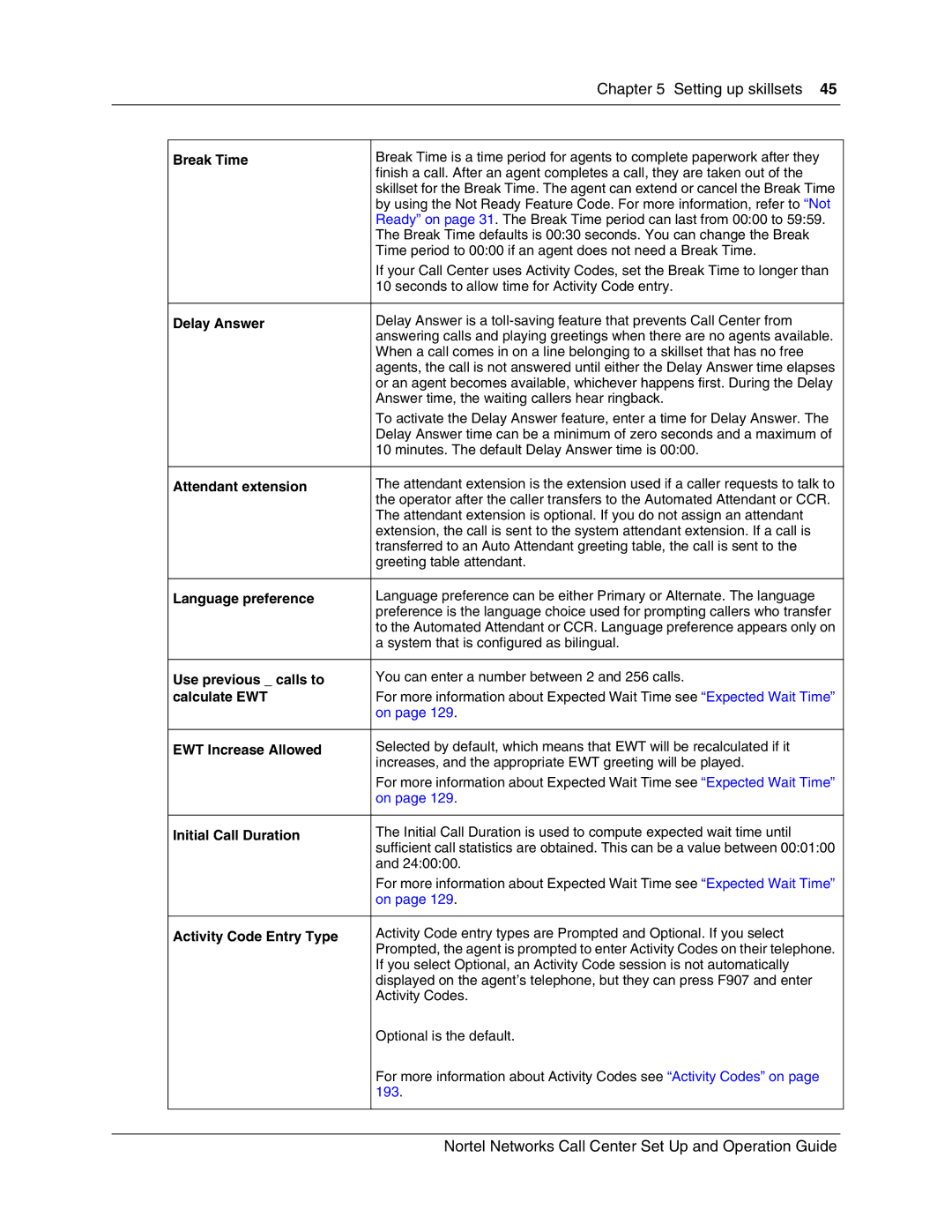|
| Chapter 5 Setting up skillsets 45 |
|
|
|
|
|
|
|
|
|
| Break Time | Break Time is a time period for agents to complete paperwork after they |
|
|
| finish a call. After an agent completes a call, they are taken out of the |
|
|
| skillset for the Break Time. The agent can extend or cancel the Break Time |
|
|
| by using the Not Ready Feature Code. For more information, refer to “Not |
|
|
| Ready” on page 31. The Break Time period can last from 00:00 to 59:59. |
|
|
| The Break Time defaults is 00:30 seconds. You can change the Break |
|
|
| Time period to 00:00 if an agent does not need a Break Time. |
|
|
| If your Call Center uses Activity Codes, set the Break Time to longer than |
|
|
| 10 seconds to allow time for Activity Code entry. |
|
|
|
|
|
| Delay Answer | Delay Answer is a |
|
|
| answering calls and playing greetings when there are no agents available. |
|
|
| When a call comes in on a line belonging to a skillset that has no free |
|
|
| agents, the call is not answered until either the Delay Answer time elapses |
|
|
| or an agent becomes available, whichever happens first. During the Delay |
|
|
| Answer time, the waiting callers hear ringback. |
|
|
| To activate the Delay Answer feature, enter a time for Delay Answer. The |
|
|
| Delay Answer time can be a minimum of zero seconds and a maximum of |
|
|
| 10 minutes. The default Delay Answer time is 00:00. |
|
|
|
|
|
| Attendant extension | The attendant extension is the extension used if a caller requests to talk to |
|
|
| the operator after the caller transfers to the Automated Attendant or CCR. |
|
|
| The attendant extension is optional. If you do not assign an attendant |
|
|
| extension, the call is sent to the system attendant extension. If a call is |
|
|
| transferred to an Auto Attendant greeting table, the call is sent to the |
|
|
| greeting table attendant. |
|
|
|
|
|
| Language preference | Language preference can be either Primary or Alternate. The language |
|
|
| preference is the language choice used for prompting callers who transfer |
|
|
| to the Automated Attendant or CCR. Language preference appears only on |
|
|
| a system that is configured as bilingual. |
|
|
|
|
|
| Use previous _ calls to | You can enter a number between 2 and 256 calls. |
|
| calculate EWT | For more information about Expected Wait Time see “Expected Wait Time” |
|
|
| on page 129. |
|
|
|
|
|
| EWT Increase Allowed | Selected by default, which means that EWT will be recalculated if it |
|
|
| increases, and the appropriate EWT greeting will be played. |
|
|
| For more information about Expected Wait Time see “Expected Wait Time” |
|
|
| on page 129. |
|
|
|
|
|
| Initial Call Duration | The Initial Call Duration is used to compute expected wait time until |
|
|
| sufficient call statistics are obtained. This can be a value between 00:01:00 |
|
|
| and 24:00:00. |
|
|
| For more information about Expected Wait Time see “Expected Wait Time” |
|
|
| on page 129. |
|
|
|
|
|
| Activity Code Entry Type | Activity Code entry types are Prompted and Optional. If you select |
|
|
| Prompted, the agent is prompted to enter Activity Codes on their telephone. |
|
|
| If you select Optional, an Activity Code session is not automatically |
|
|
| displayed on the agent’s telephone, but they can press F907 and enter |
|
|
| Activity Codes. |
|
|
| Optional is the default. |
|
|
| For more information about Activity Codes see “Activity Codes” on page |
|
|
| 193. |
|
|
|
|
|
Nortel Networks Call Center Set Up and Operation Guide
